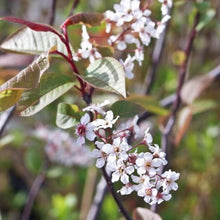Characteristics
The plant discussed in this text is also called common bird cherry, awl cherry, swamp cherry and Elsenkirsche. It also bears the botanical species name Prunus padus. Prunus padus is also known as buckthorn. However, this is not the real buckthorn Rhamnus frangula. This fact can be attributed in particular to the similarities of the bark. Prunus padus delights its owner with heights of 10-15 m and widths of 4-8 meters. The growth can be described as conical and upright.n.
Pollination and foliage
Prunus padus is monoecious. Pollination takes place both via so-called cross-pollination and via insects. Bees and hoverflies in particular are responsible for this endeavor. In addition to a simple leaf structure and an alternate leaf arrangement, the elongated leaves have a sawn leaf edge. The caterpillars of several butterfly species also feed on the leaves. The unfilled flowers in the form of grapes are white in color. The viewer can look forward to this splendor of flowers from April to June.
Soil condition
The common bird cherry likes fresh, moist and nutrient-rich soil. This wood is particularly enthusiastic about a swampy clay and loam soil. On the other hand, arid and calcareous soil variations should be avoided. Soils with a slight lime content are tolerated by Prunus padus. However, you are not doing the common bird cherry a favor with such a bottom.
Provenance
With the exception of the Balkans and the Mediterranean region, the service tree can be found in principle throughout Europe. This plant has also found a home in Japan and North Asia.
Uses
Prunus padus is very versatile. The fruits of the Elsenkirsche can be processed into various end products. Examples are juices and jams. The bark and seeds contain cyanogenic glycoside. It is suitable for splitting off hydrogen cyanide. Inlays and handles can also be made from Prunus padus wood. In Russia, the branches are used as braiding material. However, this hardy wood also has a forestry benefit. In addition to being used as an ornamental wood and as a nutrient for insects, Prunus padus can also be used for ground reinforcement. The common bird cherry needs enough space to develop its beauty. Therefore, Prunus padus is to be regarded as a solitary plant. At the end of the text, we would also like to point out the property of the Elsenkirsche as an industrial wood.


